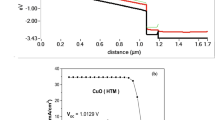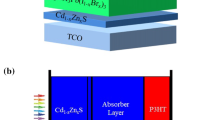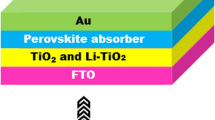Abstract
The experimental results of a perovskite solar cell with FTO/TiO2/CH3NH3PbI3/PEDOT:PSS/Pt cell architecture fabricated in our research laboratory under ambient conditions are compared with the simulated results obtained using SCAPS-1D. Optimization of the thickness of the perovskite, ETL and HTL, temperature, and the work function of the metal has been carried out to formulate a high-performance perovskite solar cell. The impacts of varying absorber thickness, ETL, temperature, and metal work function exhibit very minimal or no change. However, the device exhibits a high power conversion efficiency (PCE) in HTL thickness variation. The impact of variation in HTL thickness from 10 nm to 500 nm shows the best cell performance in terms of PCE between 10 nm and 50 nm. At 10-nm thickness, Jsc, Voc, FF, and PCE are 35.08 mA/cm2, 0.95 V, 35.08%, and 28.93%, respectively. The cell efficiency decreases with the increase in the thickness of HTL. However, at lower thicknesses, the extraction of the generated carrier is generally low. Therefore, analyzing all the results, we suggest that, to obtain a high power conversion (26.26% at 30 nm and 23.75% at 50 nm), the HTL thickness should effectively be between 30 nm and 50 nm. The structure of the studied solar cell device having such cell characteristics can be considered in the manufacturing workflow for its mass-scale production.
Graphical Abstract







Similar content being viewed by others
References
J.M. Frost, K.T. Butler, F. Brivio, C.H. Hendon, M.V. Schilfgaarde, and A. Walsh, Atomistic origins of high-performance in hybrid halide perovskite solar cells. Nano Lett. 14, 2584 (2014).
N. Nuraje and K. Su, Perovskite ferroelectric nanomaterials. Nanoscale 5, 8752 (2013).
D.B. Mitzi, Synthesis, structure, and properties of organic‐inorganic perovskites and related materials. Prog. Inorg. Chem., 1–121 (1999).
V. Dinnocenzo, G. Grancini, M.J.P. Alcocer, A.R.S. Kandada, S.D. Stranks, M.M. Lee, G. Lanzani, H.J. Snaith, and A. Petrozza, Excitons versus free charges in organo-lead tri-halide perovskites. Nat. Commun. 5(1), 3586 (2014).
J.S. Manser and P.V. Kamat, Band filling with free charge carriers in organometal halide perovskites. Nat. Photonics 8(9), 737 (2014).
W.J. Yin, J.H. Yang, J. Kang, Y. Yan, and S.H. Wei, Halide perovskite materials for solar cells: a theoretical review. J. Matter. Chem. 3, 8926 (2015).
A. Walsh and G.W. Watson, The origin of the stereochemically active Pb (II) lone pair: DFT calculations on PbO and PbS. J. Solid State Chem. 178(5), 1422 (2005).
A. Walsh, D.J. Payne, R.G. Egdell, and G.W. Watson, Stereochemistry of post-transition metal oxides: revision of the classical lone pair model. Chem. Soc. Rev. 40, 4455 (2011).
G. Xing, N. Mathews, S. Sun, S.S. Lim, Y.M. Lam, M. Gratzel, S. Mhaisalkar, and T.C. Sum, Long-range balanced electron-and hole-transport lengths in organic-inorganic CH3NH3PbI3. Science 342, 344 (2013).
S.D. Stranks, G.E. Eperon, G. Grancini, C. Menelaou, M.J.P. Alcocer, T. Leijtens, L.M. Herz, A. Petrozza, and H.J. Snaith, Electron-hole diffusion lengths exceeding 1 micrometer in an organometal trihalide perovskite absorber. Science 342, 341 (2013).
Z. Wei, H. Chen, K. Yan, and S. Yang, Inkjet printing and instant chemical transformation of a CH3NH3PbI3/nanocarbon electrode and interface for planar perovskite solar cells. Angew. Chem. 126, 13455 (2014).
Z. Li, S.A. Kulkarni, P.P. Boix, E. Shi, A. Cao, K. Fu, S.K. Batabyal, J. Zhang, Q. Xiong, and L.H. Wong, Laminated carbon nanotube networks for metal electrode-free efficient perovskite solar cells. ACS Nano 8, 6797 (2014).
P. Qin, S. Tanaka, S. Ito, N. Tetreault, K. Manabe, H. Nishino, M.K. Nazeeruddin, and M. Grätzel, Inorganic hole conductor-based lead halide perovskite solar cells with 12.4% conversion efficiency. Nat. Commun. 5, 3834 (2014).
J. Burschka, N. Pellet, S.-J. Moon, R. Humphry-Baker, P. Gao, M.K. Nazeeruddin, and M. Grätzel, Sequential deposition as a route to high-performance perovskite-sensitized solar cells. Nature 499, 316 (2013).
M. Xiao, F. Huang, W. Huang, Y. Dkhissi, Y. Zhu, J. Etheridge, A. Gray-Weale, U. Bach, Y.B. Cheng, and L. Spiccia, A fast deposition-crystallization procedure for highly efficient lead iodide perovskite thin-film solar cells. Angew. Chem. Int. Ed. Engl. 53, 9898 (2014).
M. Liu, M.B. Johnston, and H.J. Snaith, Efficient planar heterojunction perovskite solar cells by vapour deposition. Nature 501, 395 (2013).
H. Zhou, Q. Chen, G. Li, S. Luo, T.B. Song, H.S. Duan, Z. Hong, J. You, Y. Liu, and Y. Yang, Interface engineering of highly efficient perovskite solar cells. Science 345, 542 (2014).
M.A. Green, Radiative efficiency of state-of-the-art photovoltaic cells. Photovoltaics 20, 472 (2012).
U. Rau, B. Blank, T.C.M. Müller, and T. Kirchartz, Efficiency potential of photovoltaic materials and devices unveiled by detailed-balance analysis. Phys. Rev. Appl. 7, 044016 (2017).
M.M. Lee, J. Teuscher, T. Miyasaka, T.N. Murakami, and H.J. Snaith, Efficient hybrid solar cells based on meso-superstructured organometal halide perovskites. Science 338, 643 (2012).
N.J. Jeon, H. Na, E.H. Jung, T.-Y. Yang, Y.G. Lee, G. Kim, H.-W. Shin, S.I. Seok, J. Lee, and J. Seo, A fluorene-terminated hole-transporting material for highly efficient and stable perovskite solar cells. Nat. Energy 3, 682 (2018).
K. Tvingstedt, O. Malinkiewicz, A. Baumann, C. Deibel, H.J. Snaith, V. Dyakonov, and H.J. Bolink, Radiative efficiency of lead iodide based perovskite solar cells. Sci. Rep. 4, 6071 (2015).
W. Tress, N. Marinova, O. Inganas, M.K. Nazeeruddin, S.M. Zakeeruddin, and M. Graetzel, Predicting the open-circuit voltage of CH3NH3PbI3 perovskite solar cells using electroluminescence and photovoltaic quantum efficiency spectra: the role of radiative and non-radiative recombination. Adv. Energy Mater. 5, 1400812 (2015).
J.P. Correa-Baena, M. Saliba, T. Buonassisi, M. Gratzel, A. Abate, W. Tress, and A. Hagfeldt, Promises and challenges of perovskite solar cells. Science 358, 739 (2017).
J. Yao, T. Kirchartz, M.S. Vezie, M.A. Faist, W. Gong, Z. He, H. Wu, J. Troughton, T. Watson, D. Bryant, and J. Nelson, Efficiency potential of photovoltaic materials and devices unveiled by detailed-balance analysis. Phys. Rev. Appl. 4(1), 014020 (2015).
K.L. Qiu, O. Luis, and Q. Yabing, Advances and challenges to the commercialization of organic–inorganic halide perovskite solar cell technology. Mater. Today Energy 7, 169 (2018).
W.J. Yin, J.H. Yang, J. Kang, Y. Yan, and S.H. Wei, Halide perovskite materials for solar cells: a theoretical review. Chem. A 3, 8926 (2015).
P.K. Singh, R. Singh, V. Singh, S.K. Tomar, B. Bhattacharya, and Z.H. Khan, Effect of crystal and powder of CH3NH3I on the CH3NH3PbI3 based perovskite sensitized solar cell. R. Bull. 89, 292 (2017).
A. Krishna and A.C. Grimsdale, Hole transporting materials for mesoscopic perovskite solar cells–towards a rational design. J. Mater. Chem. A 5, 16446 (2017).
A. Ehtesham, W.W. Wong, H.Y. Wong, and M. Zaman, Recent advances in fabrication techniques of perovskite solar cells: a review. Am. J. Appl. Sci. 13, 1290 (2016).
S. Prasanthkumar and L. Giribabu, Recent advances in perovskite-based solar cells. Curr. Sci. 111, 1173 (2016).
W. Zhang, X. Bi, X. Zhao, Z. Zhao, J. Zhu, S. Dai, L. Yalin, and S. Yang, The effect of skin-depth interfacial defect layer in perovskite solar cell. Organ. Electron. 15, 3445 (2014).
T.R. Chou, S.H. Chen, Y.T. Chiang, Y.T. Lina, and C.Y. Chao, Highly conductive PEDOT: PSS films by post-treatment with dimethyl sulfoxide for ITO-free liquid crystal display. J. Mater. Chem. C 3(15), 3760 (2015).
O.P. Dimitrieva, D.A. Grinkoa, Y.V. Noskovb, N.A. Ogurtsovb, and A.A. Pud, PEDOT: PSS films—effect of organic solvent additives and annealing on the film conductivity. Metals 159, 2237 (2009).
X. Zhang, J. Wu, J. Wang, J. Zhang, Q. Yang, Y. Fu, and Z. Xie, Highly conductive PEDOT: PSS transparent electrode prepared by a post-spin-rinsing method for efficient ITO-free polymer solar cells. Solar Energy Mater. Solar Cells 144, 143 (2015).
S.-I. Na, G. Wang, S.-S. Kim, T.-W. Kim, O. Seung-Hwan, Y. Byung-Kwan, T. Leea, and D.-Y. Kim, Evolution of nanomorphology and anisotropic conductivity in solvent-modified PEDOT: PSS films for polymeric anodes of polymer solar cells. J. Mater. Chem. 19, 9045 (2009).
L.-C. Chen, J.-C. Chen, C.-C. Chen, and W. Chun-Guey, Fabrication and properties of high-efficiency perovskite/PCBM organic solar cells. Nanoscale Res. Lett. 10, 312 (2015).
Y. Xia, K. Sun, J. Chang, and J. Ouyang, Effects of organic inorganic hybrid perovskite materials on the electronic properties and morphology of poly (3, 4-ethylenedioxythiophene): poly (styrenesulfonate) and the photovoltaic performance of planar perovskite solar cells. J. Mater. Chem. A 3, 15897 (2015).
W. Chun-Guey, C.-H. Chiang, Z.-L. Tseng, K.M. Nazeeruddin, A. Hagfeldt, and M. Gratzel, High efficiency stable inverted perovskite solar cells without current hysteresis. Energy Environ. Sci. 8, 2725 (2015).
P. Docampo, J.M. Ball, M. Darwich, G.E. Eperon, and H.J. Snaith, Efficient organometal trihalide perovskite planar-heterojunction solar cells on flexible polymer substrates. Nat. Commun. 4(1), 1 (2013).
M. Srivastava, K. Surana, S. Singh, P.K. Singh, and R.C. Singh, Highly efficient sandwich structured Perovskite solar cell using PEDOT: PSS in room ambient conditions. Mater. Today 34, 675 (2021).
R. Singh, B. Bhattacharya, H.W. Rhee, and P.K. Singh, Solid gellan gum polymer electrolyte for energy application. Int. J. Hydrog. Energy 40, 9365 (2015).
Q. Liu, C. Leng, and J. Yuan, Quantifying the nonclassicality of pure dephasing. Mater. Sci. Eng. 452, 022135 (2018).
G. Adam, M. Kaltenbrunner, E.D. Głowacki, D.H. Apaydin, M.S. White, H. Heilbrunner, S. Tombe, P. Stadler, B. Ernecker, C.W. Klampfl, and N.S. Sariciftci, Solution processed perovskite solar cells using highly conductive PEDOT: PSS interfacial layer. Sol. Energy Mater. Sol. Cells 157, 318 (2016).
J. Burschka, N. Pellet, S.J. Moon, R. Humphry-Baker, P. Gao, M.K. Nazeeruddin, and M. Grätzel, Sequential deposition as a route to high-performance perovskite-sensitized solar cells. Nature 499, 316 (2013).
L. Et-taya, T. Ouslimane, and A. Benami, Evidence of improved power conversion efficiency in lead-free CsGeI3 based perovskite solar cell heterostructure via scaps simulation. J. Vac. Sci. Technol. B Nanotechnol. Microelectron. Mater. Process. Meas. Phenom. 39(1), 012401 (2021).
H. Abdy, A. Aletayeb, M. Bashirpour, Z. Heydari, M. Kolahdouz, E. AslSoleimani, Z. Kolahdouz, and G. Zhang, Synthesis, optical characterization, and simulation of organo-metal halide perovskite materials. Optik 191, 100 (2019).
S. Sajid, A.M. Elseman, J. Ji, S. Dou, D. Wei, H. Huang, P. Cui, W. Xi, L. Chu, Y. Li, B. Jiang, and M. Li, Computational study of ternary devices: stable, low-cost, and efficient planar perovskite solar cells. Nano-Micro Lett. 10, 51 (2018).
M. Singh, R. Kumar, and V. Singh, Investigating the impact of layer properties on the performance of p-graphene/CH3NH3PbI3/n-cSi solar cell using numerical modelling. Superlattices Microstruct. 140, 106468 (2020).
M. Mehrabian and S. Dalir, 11.73% efficient perovskite heterojunction solar cell simulated by SILVACO ATLAS software. Optik 139, 44 (2017).
L. Et-taya, T. Ouslimane, and A. Benami, Numerical analysis of earth-abundant Cu2ZnSn (SxSe1-x)4 solar cells based on spectroscopic ellipsometry results by using SCAPS-1D. Sol. Energy 201, 827 (2020).
S. Rai, B.K. Pandey, and D.K. Dwivedi, Modeling of highly efficient and low cost CH3NH3Pb(I1-xClx)3 based perovskite solar cell by numerical simulation. Opt. Mater. 100, 109631 (2020).
X. Wang, T. Zhang, Y. Lou, and Y. Zhao, All-inorganic lead-free perovskites for optoelectronic applications. Mater. Chem. Front. 3, 365 (2019).
W. Ming, H. Shi, and M.-H. Du, Large dielectric constant, high acceptor density, and deep electron traps in perovskite solar cell material CsGeI3. J. Mater. Chem. A 4, 13852 (2016).
D. Liu, Q. Li, H. Jing, and K. Wu, Pressure-induced effects in the inorganic halide perovskite CsGeI3. RSC Adv. 9, 3279 (2019).
U.-G. Jong, C.-J. Yu, Y.-H. Kye, Y.-G. Choe, W. Hao, and S. Li, First-principles study on structural, electronic, and optical properties of inorganic Ge-based halide perovskites. Inorg. Chem. 58, 4134 (2019).
K.A. Montiel, C. Yang, C.H. Andreasen, M.S. Gottlieb, M.R. Pfefferkorn, L.G. Wilson, J.L.W. Carter, and I.T. Martin, Evidence of improved power conversion efficiency in lead-free CsGeI3 based perovskite solar cell heterostructure via SCAPS simulation. J. Vac. Sci. Tech. B, Nanotech. Microelectron. Mater. Process. Measure. Phen 39(1), 1183 (2019).
D. Liu, R. Sa, and K. Wu, First-principles insight on the electronic and optical properties of Ge-based inorganic perovskites. Appl. Phys. Express 12, 071007 (2019).
I. Wycliffe, M. Maxwell, M. Christopher, M. Maurice, O. Victor, and A. Celline, Thickness dependence of window layer on CH3NH3PbI3-XClX Perovskite solar cell. Int. J. Photoenergy 2020, 8877744 (2020).
Y. Gan, X. Bi, Y. Liu, B. Qin, Q. Li, Q. Jiang, and P. Mo, Numerical investigation energy conversion performance of tin-based perovskite solar cells using cell capacitance simulator. Energies 13, 5907 (2020).
A.S. Shamsuddin, P.N.A. Fahsyar, N.A. Ludin, I. Burhan, and S. Mohamad, Device simlation of perovskite solar cells with molybdenum disulfide as active buffer layer. Bull. Electr. Eng. Inform. 8(4), 1251 (2019).
A. Hima, K.A.A.K. Le, A. Rezzoug, M.B. Yahkem, A. Khechekhouche, and I. Kemerchou, Simulation and optimization of CH3NH3PbI3 based inverted planar heterojunction solar cell using SCAPS software. Int. J. Energetica 4, 56 (2019).
K. Bibi, I. Ahmad, K. Hayat, M. Ali, S. K. Shah, Simulation and experimental device performance analysis of TiO2 based inverted organic solar cells. J. Electron. Mat. 51(9), 5181–5187 (2022).
L. Lin, L. Jiang, P. Li, B. Fan, and Y. Qiu, A modeled perovskite solar cell structure with a Cu2O hole-transporting layer enabling over 20% efficiency by low-cost low-temperature processing. J. Phys. Chem. Sol. 124, 205 (2019).
M. Lazemi, S. Asgharizadeh, and S. Bellucci, A computational approach to interface engineering of lead-free CH3NH3SnI3 highly-efficient perovskite solar cells. Phys. Chem. Chem. Phys. 20, 25683 (2018).
F. Jannat, S. Ahmed, and M.A. Alim, performance analysis of cesium formamidinium lead mixed halide based perovskite solar cell with MoOx as hole transport material via SCAPS-1D. Optik 228, 166202 (2021).
M. Kevin, W.L. Ong, G.H. Lee, and G.W. Ho, Formation of hybrid structures: copper oxide nanocrystals templated on ultralong copper nanowires for open network sensing at room temperature. Nanotechnology 22(23), 235701 (2011).
W. Ming, D. Yang, T. Li, L. Zhang, and M.-H. Du, Formation and diffusion of metal impurities in perovskite solar cell material CH3NH3PbI3: implications on solar cell degradation and choice of electrode. Adv. Sci. 5(2), 1700662 (2018).
B. Qia and J. Wang, Open-circuit voltage in organic solar cells. J. Mater. Chem. 22, 24315 (2012).
Acknowledgments
The authors thank to Marc Burgelman and his team at the University of Gen for the access of SCAPS. Authors are highly thankful to the reviewers for providing constructive comments.
Author information
Authors and Affiliations
Corresponding authors
Ethics declarations
Conflict of interest
The authors declare that they have no conflict of interest.
Additional information
Publisher's Note
Springer Nature remains neutral with regard to jurisdictional claims in published maps and institutional affiliations.
Supplementary Information
Below is the link to the electronic supplementary material.
Rights and permissions
Springer Nature or its licensor (e.g. a society or other partner) holds exclusive rights to this article under a publishing agreement with the author(s) or other rightsholder(s); author self-archiving of the accepted manuscript version of this article is solely governed by the terms of such publishing agreement and applicable law.
About this article
Cite this article
Sharma, H., Verma, V.K., Singh, R.C. et al. Numerical Analysis of High-Efficiency CH3NH3PbI3 Perovskite Solar Cell with PEDOT:PSS Hole Transport Material Using SCAPS 1D Simulator. J. Electron. Mater. 52, 4338–4350 (2023). https://doi.org/10.1007/s11664-023-10257-5
Received:
Accepted:
Published:
Issue Date:
DOI: https://doi.org/10.1007/s11664-023-10257-5




